The Best Homemade Lemon Pound Cake Recipe: Moist, Zesty & Easy!
Prepare to fall in love with this irresistible Lemon Pound Cake Recipe! It’s a true classic for a reason, offering an exquisite blend of bright lemon flavor that dances on your palate. Crowned with a sweet yet tangy lemon glaze, this homemade treat is not just a dessert; it’s an experience. Dive into our step-by-step guide to bake a pound cake that’s perfectly moist, tender, and bursting with fresh citrus goodness, making it a standout for any occasion.
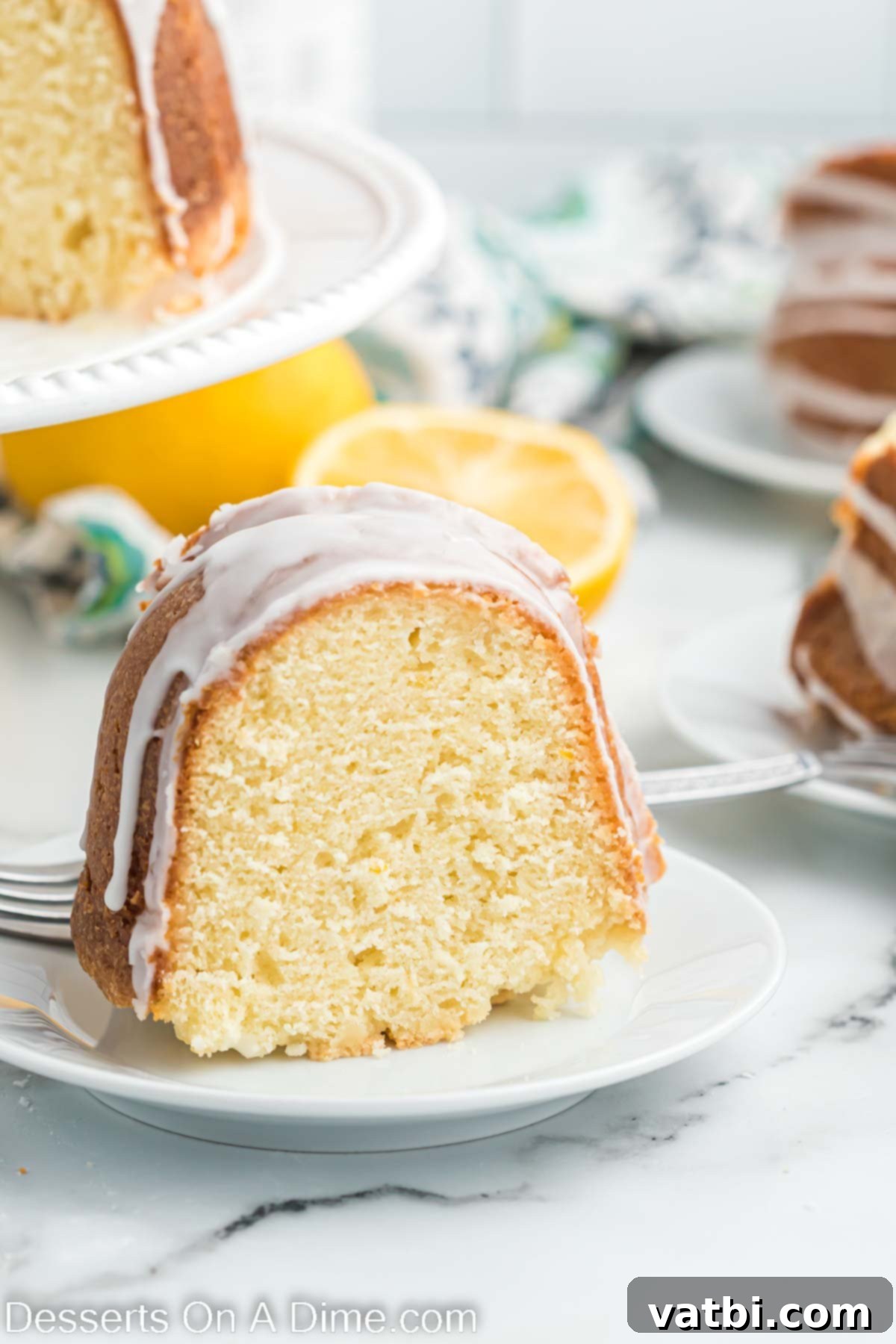
This pound cake is genuinely remarkable, loaded with an abundance of fresh lemon essence. The vibrant zest infuses the cake with a delightful fragrance and an intense, authentic lemon taste. A luscious lemon glaze is generously drizzled over the entire cake, adding an extra layer of sweetness and tartness that perfectly complements the rich, buttery crumb. Each bite promises a symphony of flavors, making it a truly exceptional dessert.
Every single slice of this amazing lemon pound cake is a culinary delight. Its comforting yet sophisticated flavor profile makes it an ideal dessert for any gathering, from casual brunches to elegant dinner parties. Serve it alongside your favorite hot beverage, or pair it with another easy pound cake recipe for a dessert table that everyone will rave about. This lemon pound cake is guaranteed to be a hit with friends and family alike.
If you’re a fan of citrusy treats and craving more lemon-infused recipes, be sure to explore our other fantastic options. You’ll love making our classic lemon cake recipe, the incredibly simple 2-ingredient lemon bars, and the ever-popular lemon squares recipe. We also highly recommend our delightful Lemon Blossoms for another burst of lemon flavor.
For those who love to experiment with different pound cake varieties, we have more delicious options to satisfy your cravings. Try our decadent Red Velvet Pound Cake or the rich and indulgent Chocolate Pound Cake. Each offers a unique flavor profile while maintaining the beloved dense and moist texture of a classic pound cake.
Table of Contents
- Why This Lemon Pound Cake is a Must-Try
- The Magic of Lemon in Desserts
- Ingredients
- Cake Ingredients
- Glaze Ingredients
- Essential Baking Tools
- How to Make the Perfect Lemon Pound Cake
- Storage and Freezing
- Expert Tips for Success
- Serving Suggestions
- Variations on a Classic
- More Easy Cake Recipes
Why This Lemon Pound Cake is a Must-Try
This lemon pound cake recipe takes the traditional pound cake to a whole new level by infusing it with an abundance of fresh, bright lemon flavor. Unlike plain pound cakes, this version incorporates both fresh lemon juice and fragrant lemon zest directly into the cake batter. This dual approach ensures that every forkful is bursting with an intense and authentic citrus taste, making it incredibly refreshing and utterly delicious.
But the lemon goodness doesn’t stop there! The final touch is a tangy lemon glaze, made with even more fresh lemon juice, which is generously drizzled over the cooled cake. This creates a perfect balance of sweetness and tartness, making the cake vibrant and truly unforgettable. It’s a dessert that’s both comforting and elegant, perfect for brightening up any day or celebrating special moments. You’ll appreciate how the simple addition of fresh lemon transforms a classic into an extraordinary culinary experience.
The Magic of Lemon in Desserts
Lemon is a powerhouse ingredient in the world of desserts, renowned for its ability to cut through richness and add a refreshing zest. In this lemon pound cake, both lemon juice and lemon zest play crucial roles. Lemon juice provides that essential tartness and moisture, preventing the cake from becoming overly sweet and creating a tender crumb. Meanwhile, lemon zest, packed with aromatic oils, delivers a concentrated, vibrant citrus fragrance and flavor that elevates the entire dessert.
The combination of these two lemon elements ensures a multi-dimensional flavor profile, bright and invigorating. It’s this natural acidity and intense aroma that make lemon desserts so appealing and memorable. The uplifting quality of lemon transforms a simple pound cake into a sophisticated and delightfully refreshing treat, leaving a clean and satisfying finish after every bite. It’s the secret behind that vibrant, sunny taste you crave.
Ingredients
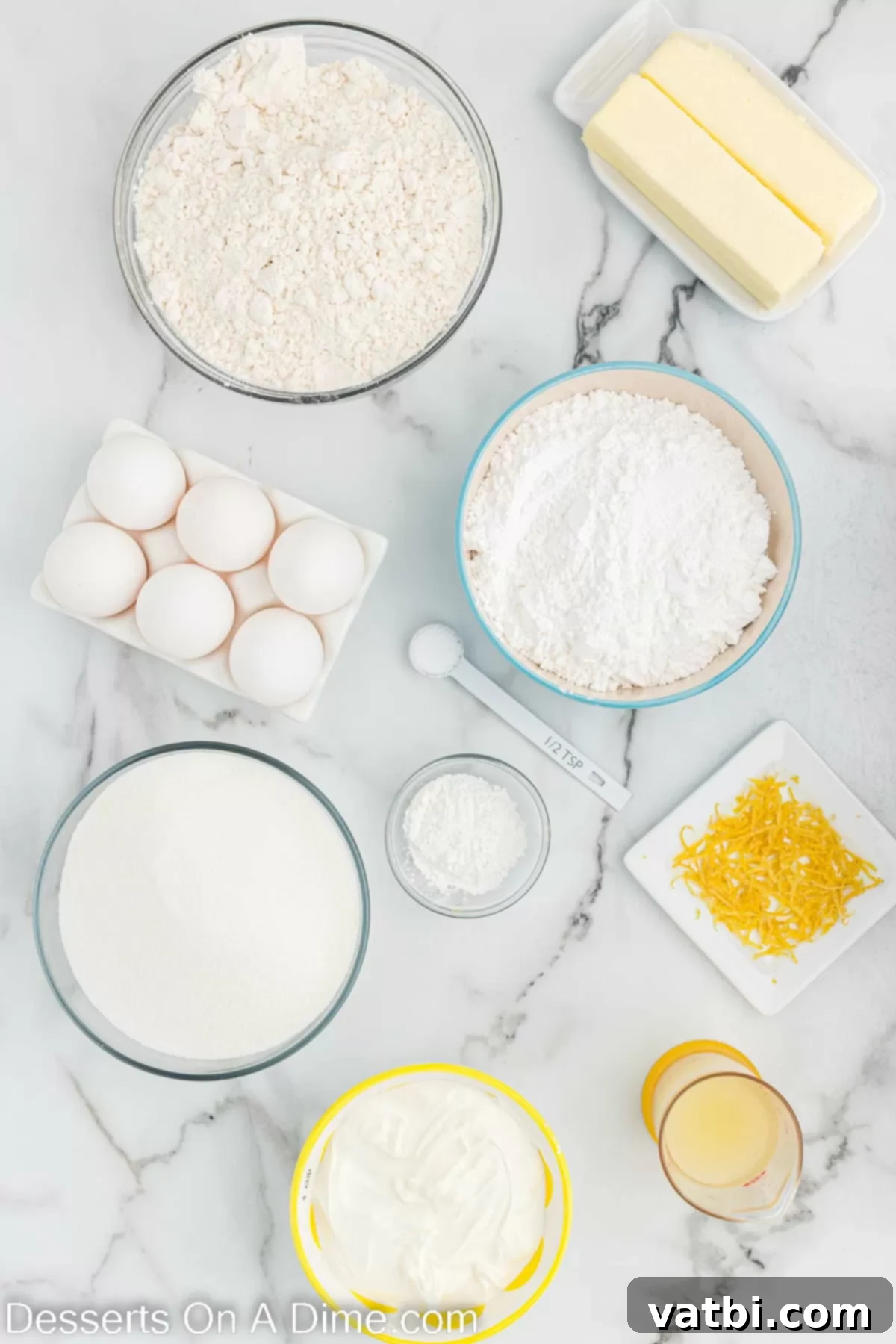
Cake Ingredients
- All-Purpose Flour: The foundation of our pound cake. For accurate measurements and a perfectly textured cake, always spoon the flour into your measuring cup and then level it off with a straight edge, rather than scooping directly from the bag. This prevents over-packing the flour, which can lead to a dry, dense cake.
- Baking Powder: Our leavening agent, crucial for giving the cake a slight lift and tender crumb. Ensure your baking powder is fresh for optimal results.
- Salt: A small but mighty ingredient that balances the sweetness and enhances all the other flavors, especially the lemon.
- Granulated Sugar: Provides sweetness and helps create a light and fluffy texture when creamed with butter. Don’t skimp on this, it’s a pound cake after all!
- Unsalted Butter: Softened at room temperature, this is key for proper emulsification with sugar, resulting in a tender and moist crumb. Using unsalted butter allows you to control the overall salt content of the recipe.
- Large Eggs: Also at room temperature, eggs act as a binding agent, add richness, and contribute to the cake’s structure and moisture. Room temperature eggs blend more evenly into the batter.
- Sour Cream: This secret ingredient is absolutely vital for achieving that incredibly moist and tender pound cake texture. Its acidity also helps activate the baking powder. If you don’t have sour cream, plain full-fat Greek yogurt can be a good substitute.
- Fresh Lemon Juice: For the most vibrant and authentic lemon flavor, always opt for freshly squeezed lemon juice. Bottled juice simply won’t deliver the same bright, zesty notes.
- Zest of One Lemon: Don’t underestimate the power of lemon zest! It’s where most of the lemon’s essential oils and intense flavor reside. Use a microplane zester to get just the yellow part, avoiding the bitter white pith. This adds a depth of citrus aroma that juice alone cannot provide.
Glaze Ingredients
- Confectioners’ Sugar (Powdered Sugar): This fine sugar is essential for a smooth, lump-free glaze. Be sure to sift it before mixing to remove any potential lumps and ensure a silky consistency.
- Fresh Lemon Juice: The glaze is incredibly delicious and perfectly balanced with fresh lemon juice. It provides a tangy counterpoint to the sweetness of the powdered sugar, creating a bright finish that perfectly complements the cake.
Find the exact measurements for all ingredients conveniently listed in the full recipe card at the bottom of the page.
Essential Baking Tools
Having the right tools can make all the difference in ensuring your lemon pound cake comes out perfectly. Here’s a list of key equipment you’ll need for this recipe:
- 15-Cup Bundt Pan: The star of the show for achieving that iconic pound cake shape. Ensure it’s properly greased and floured for an easy release.
- Stand Mixer or Hand Mixer: Essential for creaming the butter and sugar until light and fluffy, and for incorporating ingredients smoothly.
- Large and Medium Mixing Bowls: For separating wet and dry ingredients, and then combining them without overcrowding.
- Whisk: For blending dry ingredients and preparing the glaze.
- Rubber Spatula or Wooden Spoon: Ideal for gently folding ingredients and scraping down the sides of the bowl.
- Measuring Cups and Spoons: For accurate ingredient proportions.
- Microplane Zester: To get the finest lemon zest without including the bitter white pith.
- Citrus Juicer: For extracting fresh lemon juice efficiently.
- Wire Rack: Crucial for cooling the cake completely and allowing the glaze to set evenly.
- Toothpicks or Cake Tester: For checking the cake’s doneness during baking.
How to Make the Perfect Lemon Pound Cake
Crafting this delightful lemon pound cake is a rewarding process. Follow these detailed steps to ensure a flawless, delicious result every time:
- Step 1. Prepare Your Workspace: Begin by preheating your oven to 325 degrees F (160°C). This ensures the oven is at the correct temperature when your batter is ready to go in. Simultaneously, prepare your 15-cup bundt pan by generously greasing it with butter or shortening, then dusting it thoroughly with flour. Shake out any excess flour. This vital step prevents sticking and guarantees a beautiful, intact cake when inverted.
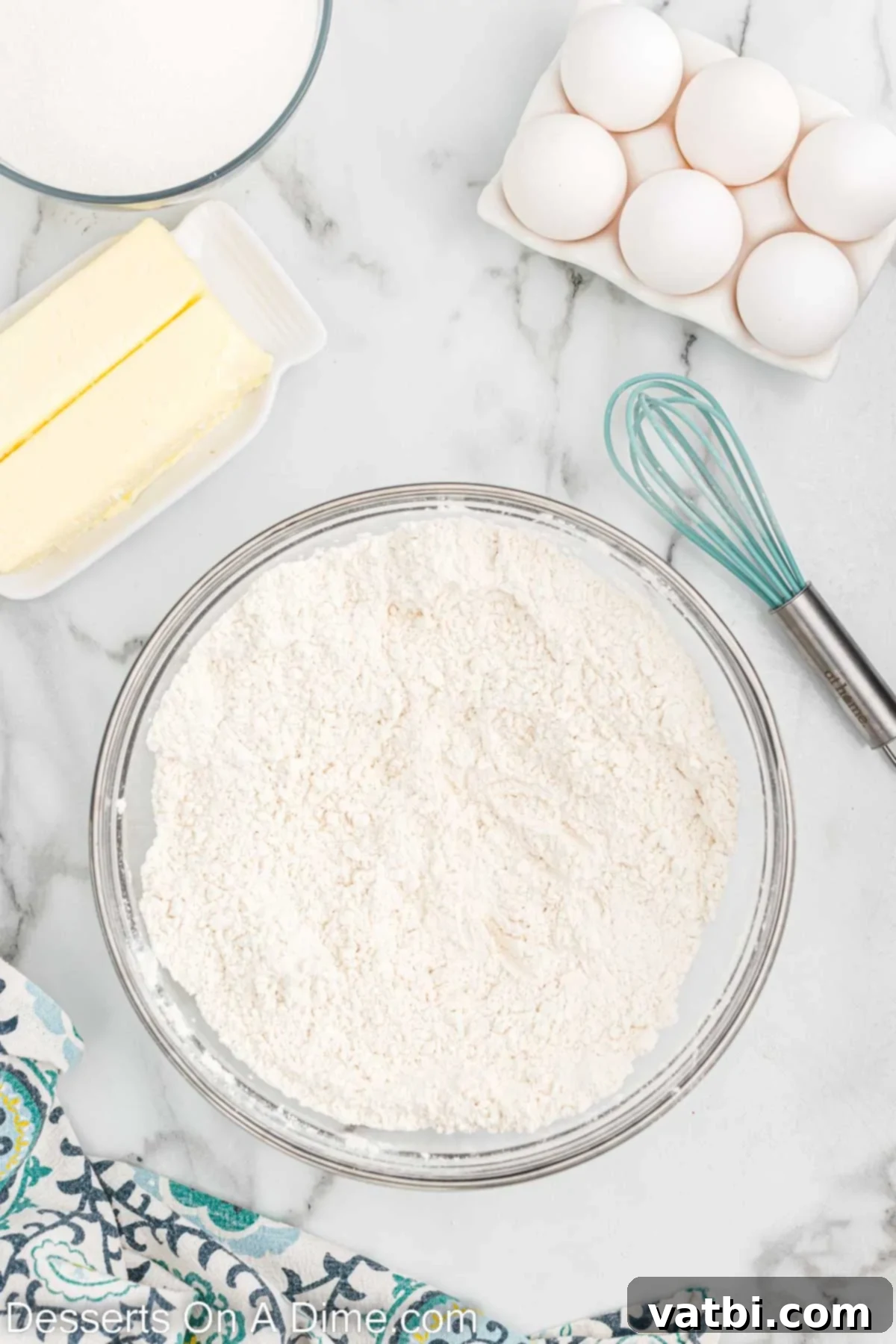
Step 2. Combine the Dry Ingredients: In a large mixing bowl, whisk together the measured all-purpose flour, baking powder, and salt. Whisking ensures these ingredients are evenly distributed, particularly the leavening agent, which is crucial for a consistent rise. Set this flour mixture aside.
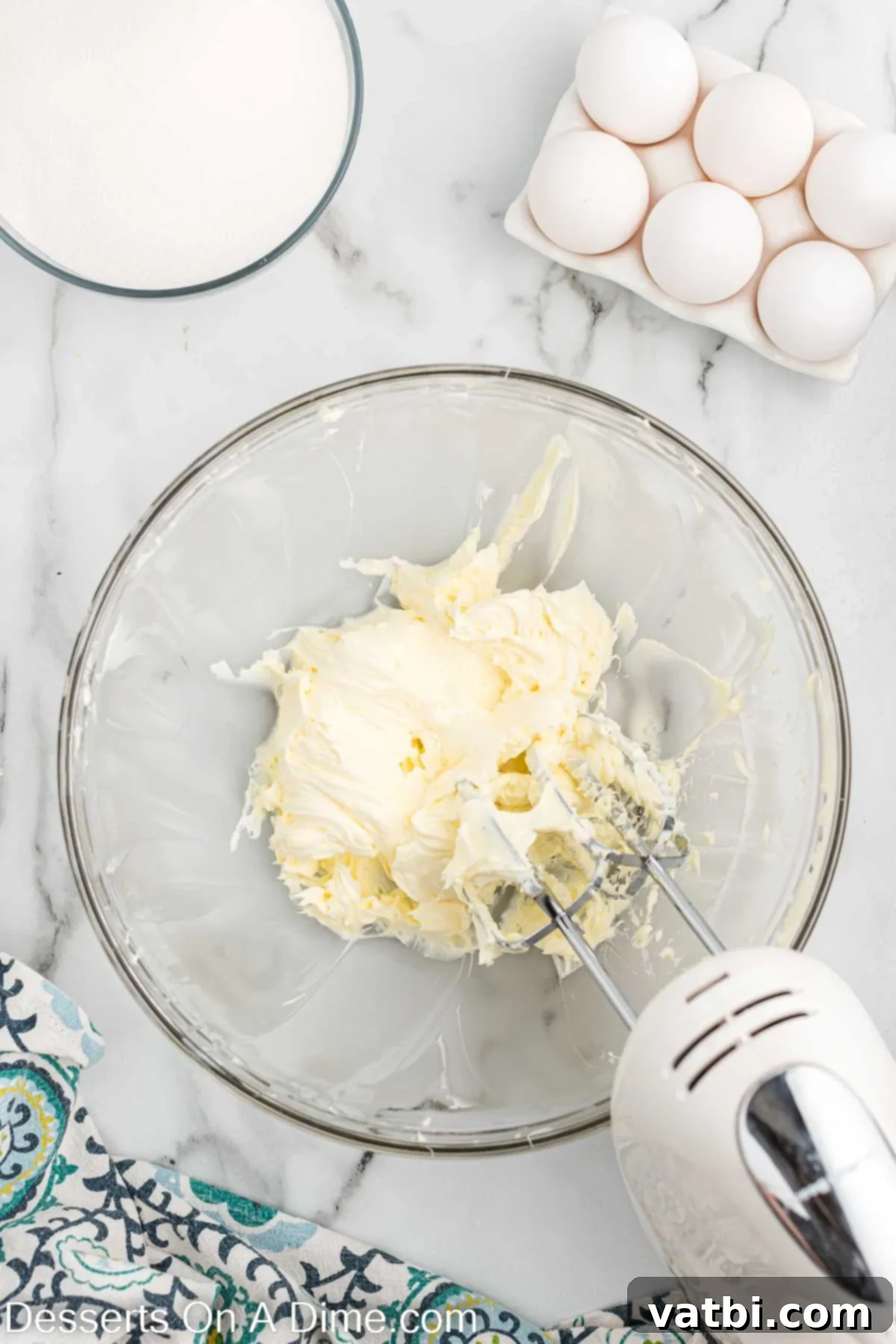
Step 3. Cream Butter and Sugar: In a separate, medium-sized mixing bowl, use a stand mixer or a hand mixer to beat the softened unsalted butter until it is light and fluffy. This initial step incorporates air, which contributes to the pound cake’s tender texture.
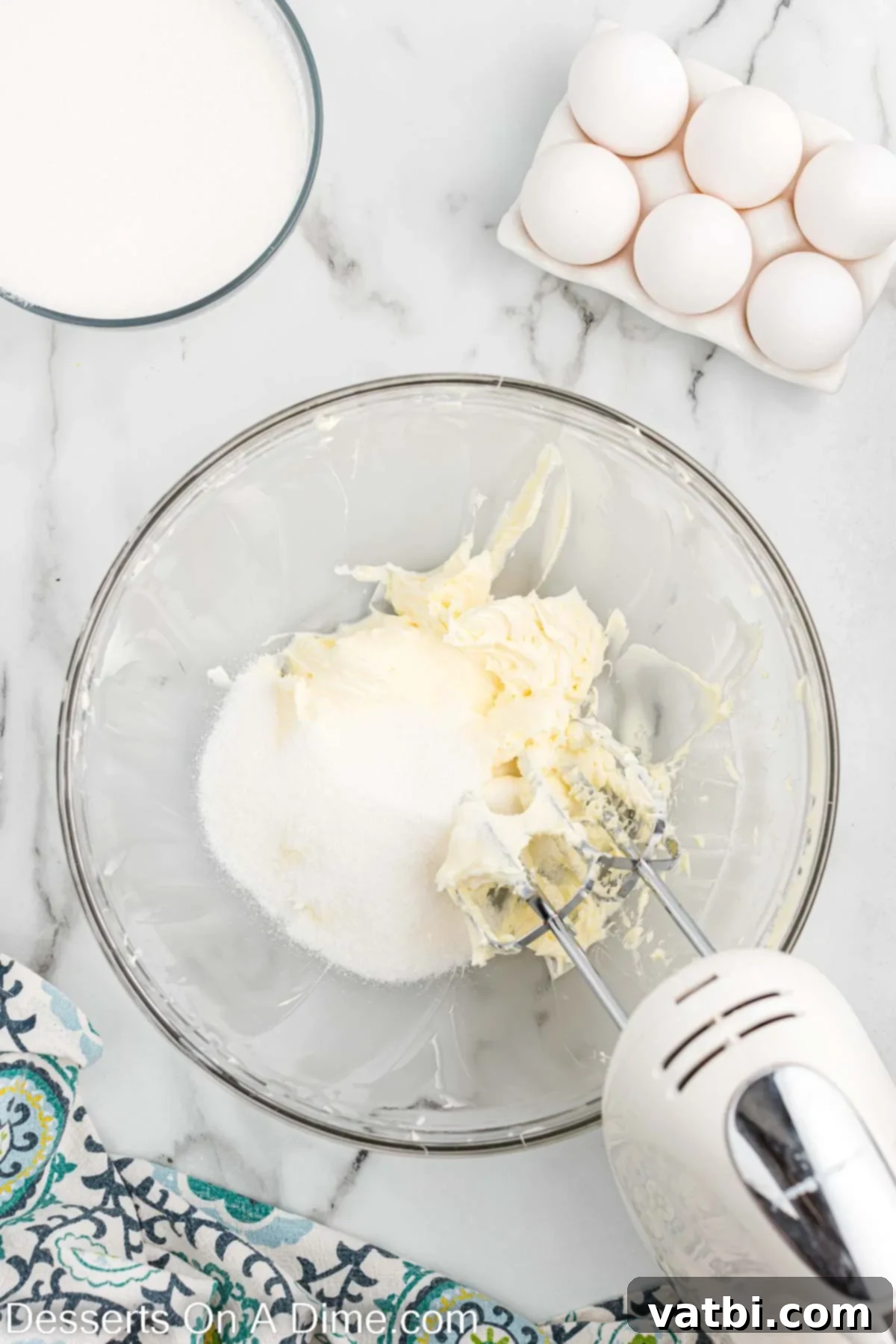
Step 4. Incorporate Sugar: Gradually add the granulated sugar to the creamed butter. Continue to beat the mixture on medium-high speed.

Step 5. Achieve Fluffy Consistency: Continue mixing for 3-5 minutes until the butter and sugar are fully combined, pale in color, and exceptionally light and fluffy. This creates tiny air pockets that will expand during baking, contributing to a tender crumb.
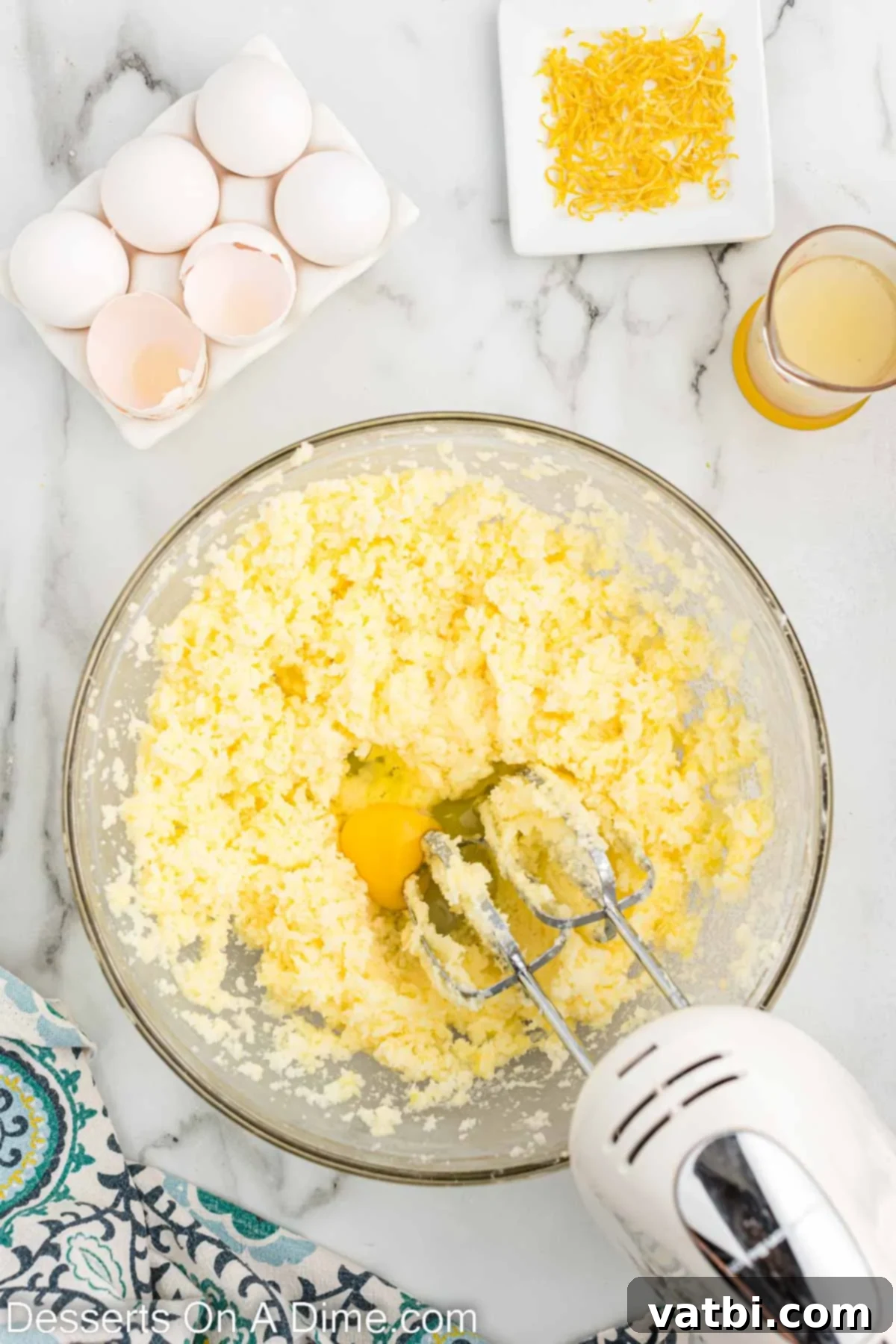
Step 6. Add Eggs Gradually: Add the large eggs one at a time to the butter and sugar mixture. This slow addition allows each egg to fully incorporate and emulsify with the fat, preventing the batter from curdling and ensuring a smooth, cohesive texture.
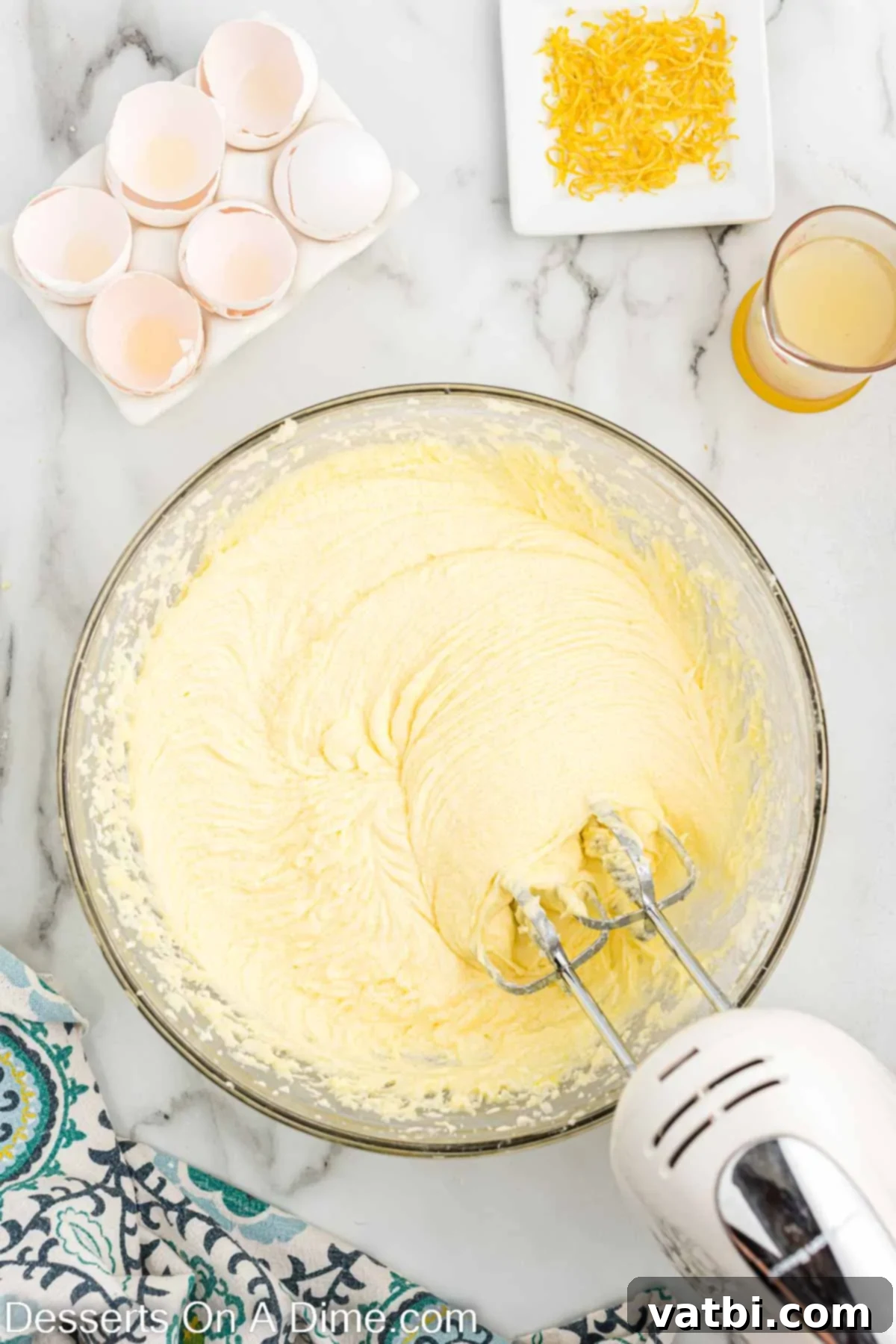
Step 7. Mix After Each Egg: After each egg is added, mix until it is fully incorporated into the batter. This step is crucial for building the cake’s structure and ensuring a smooth, uniform consistency.
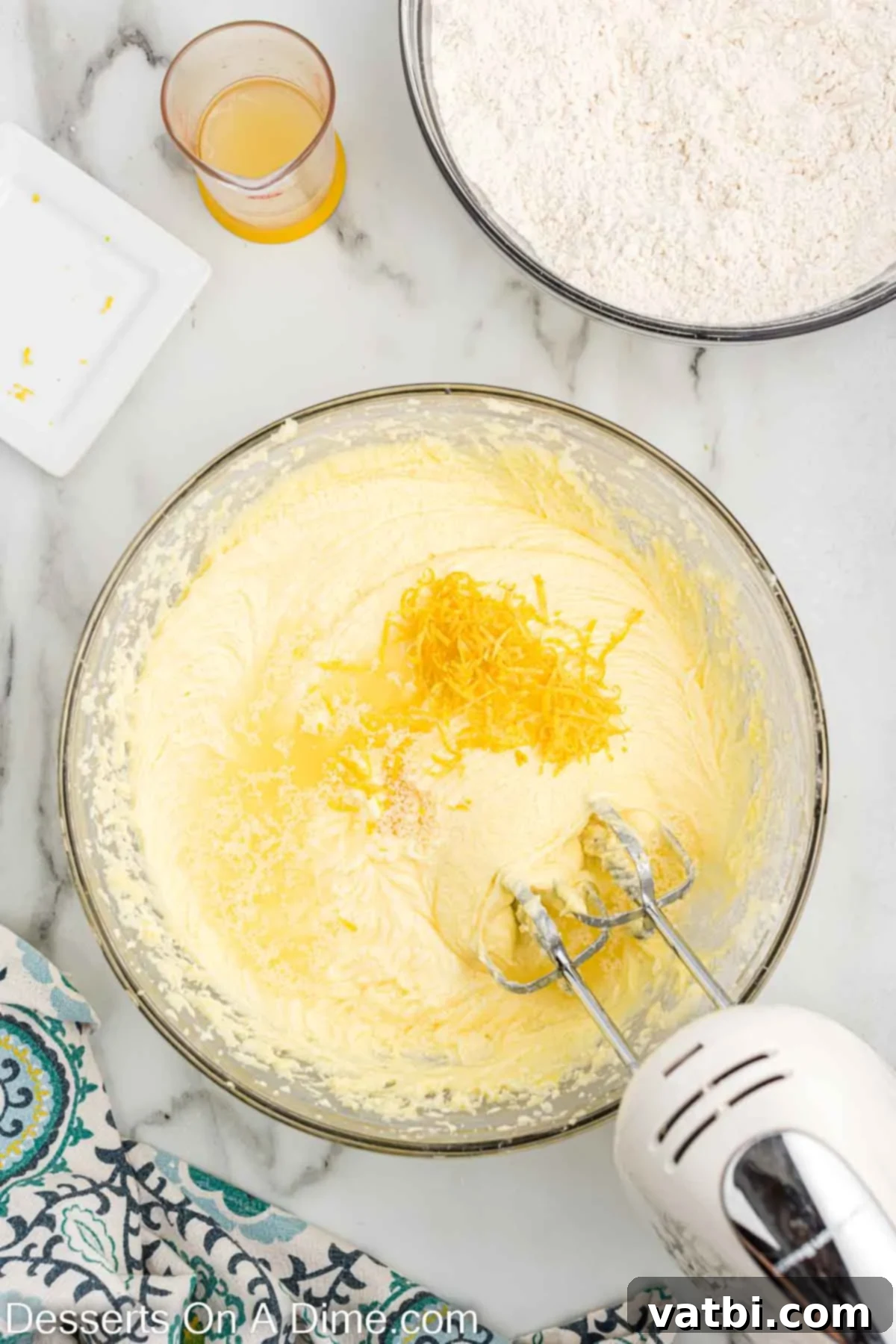
Step 8. Add Lemon Flavor: Once the eggs are fully incorporated, mix in the fresh lemon juice and lemon zest. These ingredients are vital for giving the pound cake its signature bright and tangy flavor. Mix until just combined.
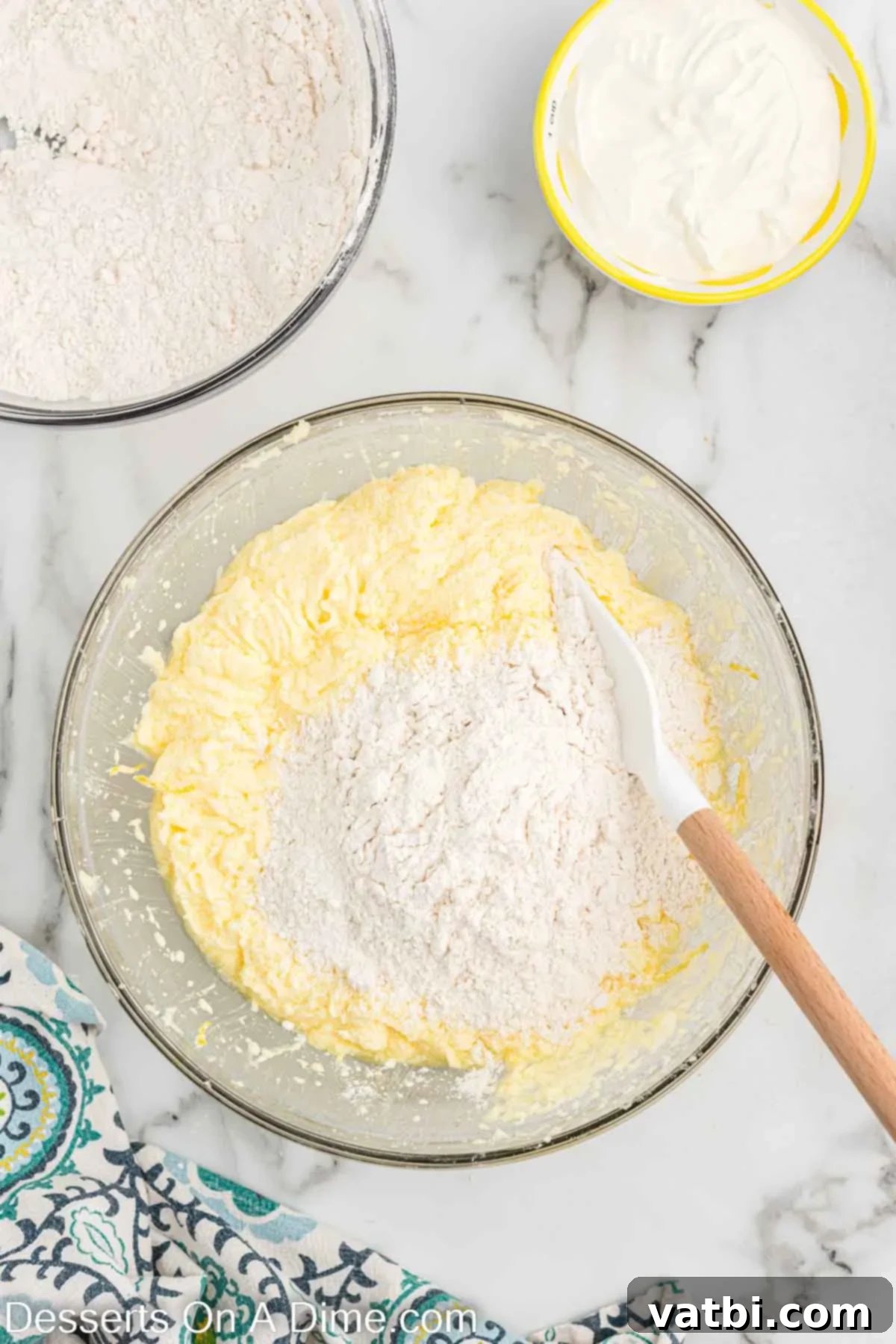
Step 9. Combine Wet and Dry Ingredients: With a wooden spoon or spatula, gradually fold the reserved dry ingredients into the wet mixture. Mix until just combined. It is crucial to be careful not to overmix the batter, as overmixing can develop the gluten in the flour, leading to a tough, dense pound cake rather than a tender one.
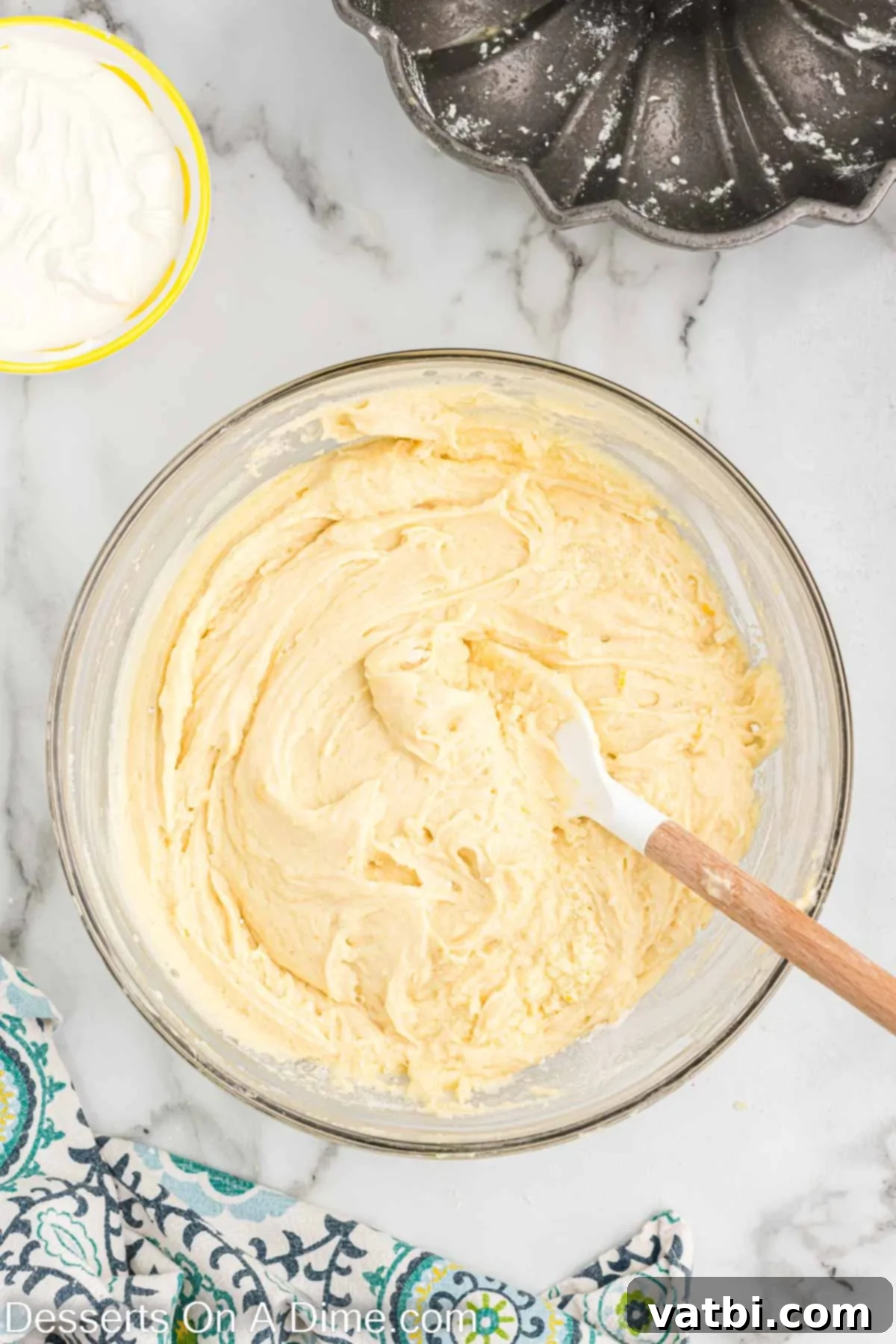
Step 10. Incorporate Sour Cream: Finally, gently fold in the sour cream. This ingredient is key to achieving the signature moist and tender crumb of the pound cake. Mix until just incorporated.

Step 11. Fill the Bundt Pan: Pour the luscious batter evenly into the prepared bundt pan. Gently tap the pan on the countertop a few times to release any air bubbles and ensure the batter settles evenly.
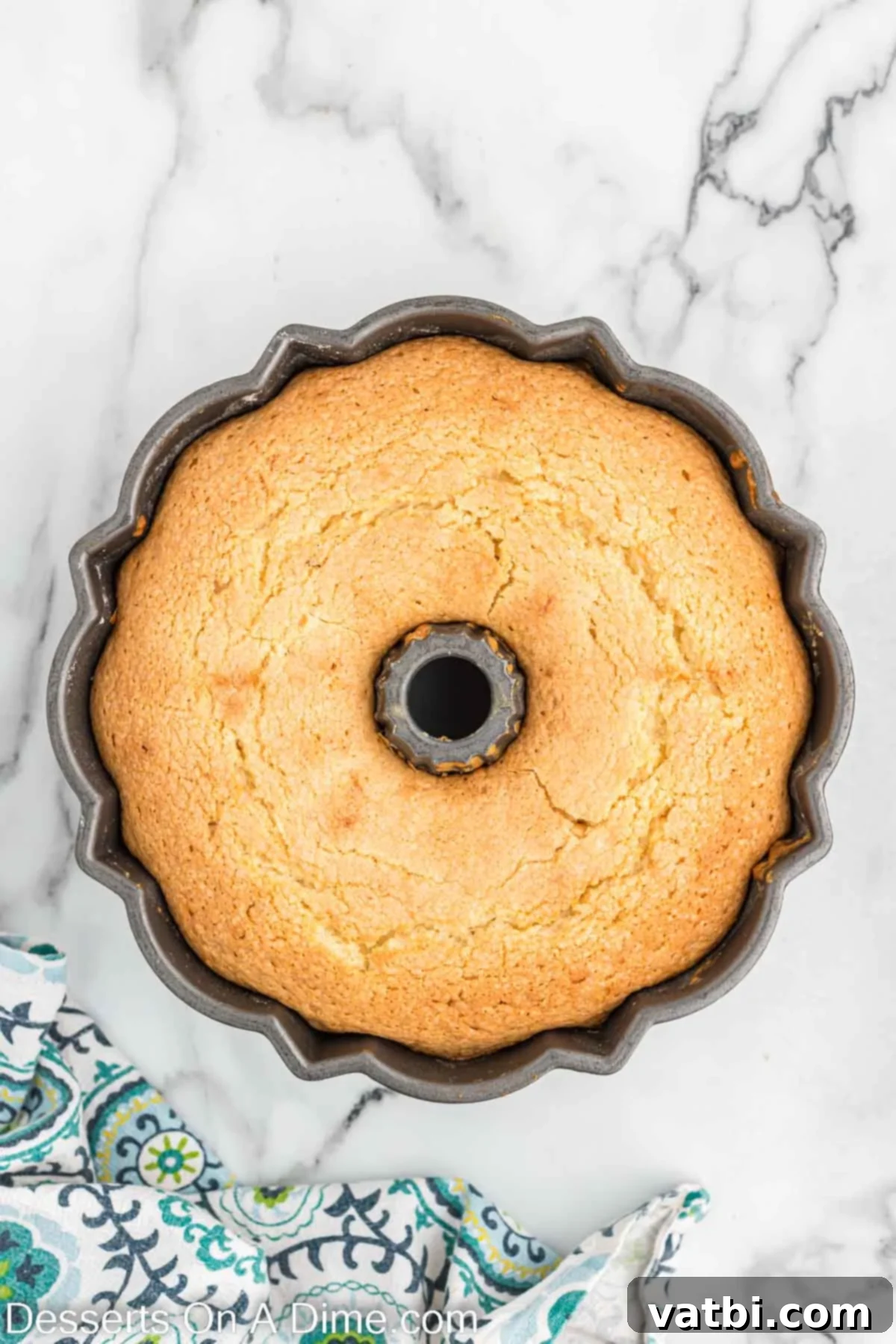
Step 12. Bake and Cool: Bake the cake in the preheated oven for 1 hour and 15 to 30 minutes. Baking times can vary, so check for doneness by inserting a toothpick into the center of the cake; it should come out clean or with just a few moist crumbs attached. Once baked, let the cake cool in the bundt pan for 15-20 minutes. This cooling period helps the cake firm up and prevents it from breaking when removed.
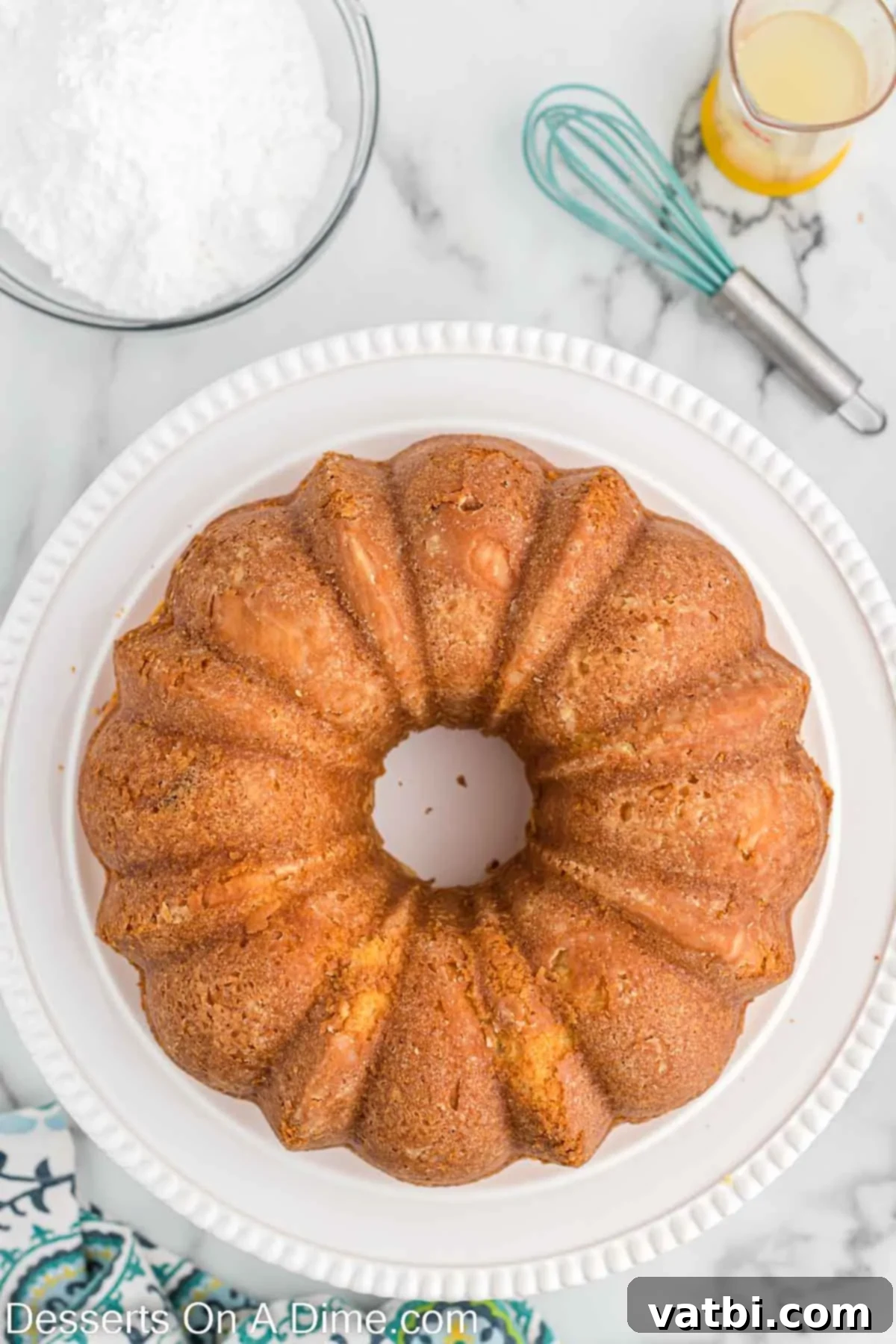
Step 13. Remove and Finish Cooling: After the initial cooling, gently run a knife around the edges of the cake in the pan if necessary, then invert it onto a wire rack. Allow the cake to cool completely on the wire rack before attempting to glaze it. This is crucial; if the cake is warm, the glaze will simply melt and run off. Once fully cooled, carefully transfer the cake to a serving plate or platter.
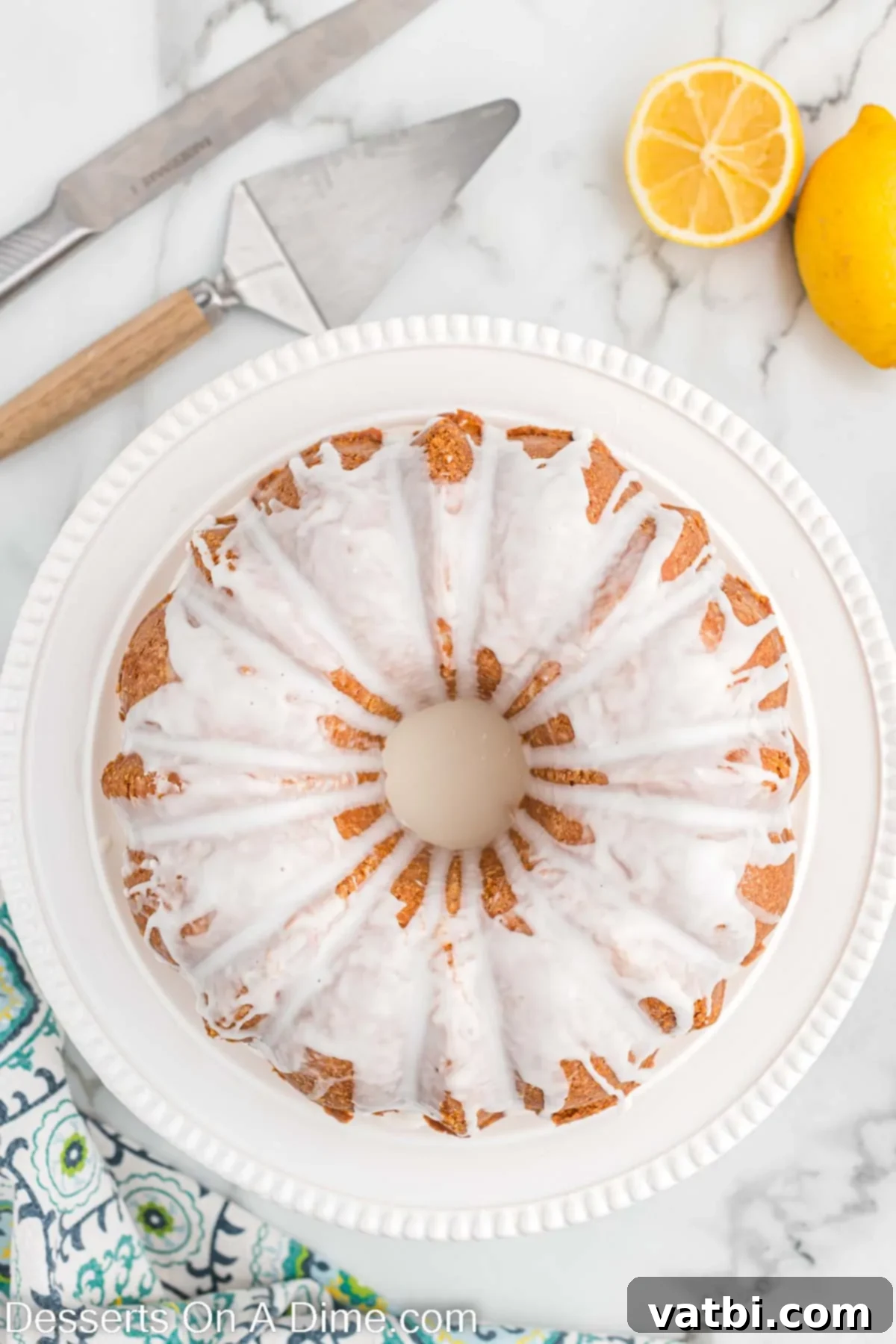
Step 14. Make and Apply the Glaze: While your cake is cooling, prepare the vibrant lemon glaze. In a small bowl, whisk together the sifted confectioners’ sugar and fresh lemon juice until the mixture is smooth and free of lumps. The consistency should be thick enough to drizzle but still pourable. Once the cake is completely cool, generously drizzle the lemon glaze all over the top, letting it cascade down the sides. Adjust thickness with more sugar or juice if needed.

Step 15. Set and Serve: Allow the glaze to set for about 15-20 minutes at room temperature until it has firmed up slightly. Once set, your magnificent homemade lemon pound cake is ready to be sliced and served! It’s always a big hit whenever I make it, and I’m sure it will be for you too.
Storage and Freezing
Proper storage is key to keeping your delicious lemon pound cake fresh and moist for as long as possible. Here’s how to ensure it stays perfect:
Storage: To maintain its freshness, store any leftover lemon pound cake at room temperature. It’s best kept covered tightly in an airtight container or under a cake stand with a dome. This prevents the cake from drying out and keeps it moist for up to 1 week. Avoid refrigerating pound cake unless it contains a perishable filling, as the cold air can dry it out. However, if your kitchen is very warm, a brief stint in the fridge might be necessary, but bring it back to room temperature before serving for the best texture and flavor.
How to Freeze?
This lemon pound cake freezes beautifully, making it an excellent dessert to prepare ahead of time or to save for later enjoyment. For best results, ensure the cake is completely cool and the lemon glaze has fully set before freezing. This prevents ice crystals from forming and preserves the cake’s texture.
To freeze, you have a couple of options: you can wrap the entire cake (without the glaze if you prefer to glaze fresh) tightly in several layers of plastic wrap, then an outer layer of aluminum foil. For individual slices, wrap each slice separately in plastic wrap and foil. Place the well-wrapped cake or slices into a large freezer bag or an airtight freezer-safe container. The cake can be frozen for up to 3 months without compromising flavor or texture. When you’re ready to enjoy it, simply thaw the cake overnight in the refrigerator. Once thawed, you can add fresh glaze if you froze it unglazed. For more detailed tips on freezing, refer to our guide on Can You Freeze Pound Cake.
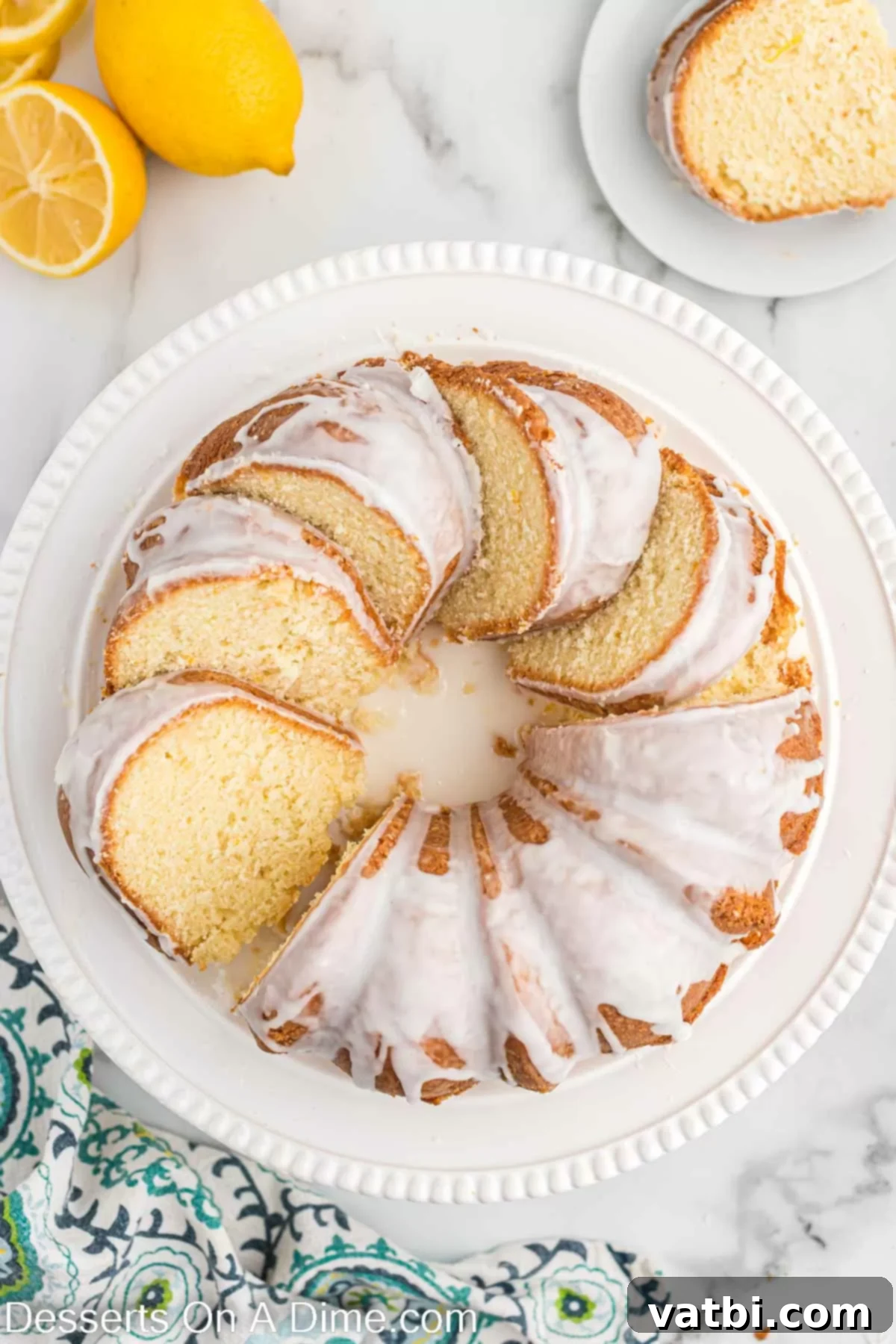
Expert Tips for Success
Achieving a perfectly moist, flavorful, and beautiful lemon pound cake is easy with these expert tips:
- Flour the Pan Thoroughly: Do not rely solely on non-stick cooking spray for your bundt pan. To ensure your cake releases cleanly and beautifully, generously grease the pan with butter or shortening, then dust it evenly with flour, tapping out any excess. This creates a non-stick barrier that’s essential for bundt cakes.
- Avoid Overmixing the Batter: Once you combine the wet and dry ingredients, mix only until they are just incorporated. Overmixing develops gluten in the flour, which can lead to a tough, rubbery, and overly dense pound cake instead of the desired tender and moist texture.
- Ensure Cake is Completely Cooled Before Glazing: Patience is key here! If you drizzle the glaze over a warm cake, it will simply melt, absorb into the cake, and create a sticky mess rather than a beautiful, set glaze. Allow the cake to cool fully on a wire rack for several hours.
- Use Room Temperature Ingredients: For the best texture and a smooth, emulsified batter, make sure your butter, eggs, and sour cream are at room temperature. This allows them to combine more easily and evenly, creating a uniform batter that bakes beautifully.
- Measure Flour Accurately: Precision in measuring flour is crucial. Instead of scooping flour directly with your measuring cup (which compacts it and leads to too much flour), use a spoon to lightly fill the measuring cup, then level it off with the back of a knife. This “spoon and level” method ensures you use the correct amount.
- Verify Baking Powder Freshness: Baking powder is a leavening agent, and its potency directly impacts your cake’s rise. Always use fresh baking powder; if it’s expired, your cake might not rise properly. You can test its freshness by adding a teaspoon to a cup of hot water; if it fizzes, it’s good to go!
- Choose Good Quality Ingredients: The quality of your ingredients significantly affects the final flavor. Always use real unsalted butter, not margarine, for a rich and authentic taste. Fresh, ripe lemons for both juice and zest are also non-negotiable for that vibrant lemon flavor.
- Don’t Overbake: Overbaking is the quickest way to a dry pound cake. Start checking for doneness at the lower end of the suggested baking time. A toothpick inserted into the center should come out clean or with minimal moist crumbs.
- Adjust Glaze Consistency: The perfect glaze consistency is thick enough to coat a spoon but still pourable. If your glaze is too thick, add a tiny bit more lemon juice (half a teaspoon at a time). If it’s too thin, whisk in a little more sifted confectioners’ sugar.
Serving Suggestions
This lemon pound cake is delicious on its own, but here are some delightful ways to serve it to impress your guests and elevate the experience:
- Plain and Simple: Sometimes, the best way to enjoy a classic is just as it is. The rich lemon flavor and moist texture speak for themselves.
- With Fresh Berries: A vibrant mix of fresh raspberries, blueberries, or sliced strawberries adds color, freshness, and a lovely tart contrast to the sweet cake.
- Dollop of Whipped Cream: A generous dollop of freshly whipped cream provides a light, airy complement to the dense pound cake.
- Scoop of Vanilla Ice Cream: For a truly decadent treat, serve a warm slice of pound cake with a scoop of premium vanilla bean ice cream. The melting ice cream creates a delicious sauce.
- Alongside Tea or Coffee: Perfect for an afternoon tea or as a delightful companion to your morning coffee.
- Lemon Curd: A spoonful of homemade or store-bought lemon curd on the side intensifies the lemon flavor and adds an extra layer of creamy richness.
Variations on a Classic
While this lemon pound cake is perfect as is, you can easily adapt it to create new and exciting flavors. Here are a few ideas to inspire you:
- Lemon Poppy Seed Pound Cake: Add 2-3 tablespoons of poppy seeds to the dry ingredients for a delightful texture and classic flavor pairing.
- Lemon Blueberry Pound Cake: Gently fold 1 to 1.5 cups of fresh or frozen blueberries (tossed in a tablespoon of flour to prevent sinking) into the batter just before pouring it into the pan.
- Lemon Raspberry Pound Cake: Similar to blueberries, fold in fresh raspberries for a sweet and tart twist.
- Coconut Lemon Pound Cake: Add 1/2 cup of shredded unsweetened coconut to the batter and consider adding a hint of coconut extract for a tropical flair.
- Gluten-Free Lemon Pound Cake: For a gluten-free option, substitute the all-purpose flour with an equal amount of your favorite 1:1 gluten-free baking flour blend. Ensure your blend contains xanthan gum for best results.
More Easy Cake Recipes
If you loved making this lemon pound cake, you’re sure to enjoy these other delightful and easy cake recipes from our collection:
- Banana Bundt Cake
- Cherry Pineapple Dump Cake Recipe
- Orange Pound Cake
- Butterscotch Cake Recipe
- Strawberry Lemonade Bundt Cake Recipe
- Chocolate Bundt Cake Recipe
Don’t wait to bake this fantastic Lemon Pound Cake recipe! It’s incredibly simple to make a flavorful pound cake from scratch, and the results are truly rewarding. We encourage you to try it today and experience the joy of homemade baking. Please leave a star rating and comment below to share your experience – we can’t wait to hear all about your delicious creation!
Pin
Lemon Pound Cake Recipe
Ingredients
FOR THE CAKE:
- 3 cups All Purpose Flour
- 1 Tablespoon Baking Powder
- 1/2 teaspoon Salt
- 3 cups Granulated Sugar
- 1 cup Unsalted Butter softened at room temperature
- 6 Large Eggs at room temperature
- 1 cup Sour Cream
- 1/3 cup Fresh Lemon Juice
- Zest of One Lemon
FOR THE GLAZE:
- 1 1/2 cup Confectioners Sugar
- 3 Tablespoons Lemon Juice
Instructions
-
Preheat your oven to 325 degrees F (160°C). Prepare a 15-cup bundt pan by thoroughly greasing and flouring it to ensure a clean release.
-
In a large mixing bowl, whisk together the all-purpose flour, baking powder, and salt. Set this dry mixture aside.
-
In a separate medium bowl, using an electric mixer (stand or hand), beat the softened unsalted butter until it is light and fluffy. Gradually add the granulated sugar, continuing to beat for 3-5 minutes until the mixture is light, pale, and very fluffy.
-
Add the large eggs one at a time, mixing well after each addition until fully incorporated. Then, mix in the fresh lemon juice and lemon zest until just combined.
-
Using a wooden spoon or spatula, gently fold the dry ingredients into the wet ingredients. Mix until just combined, being careful not to overmix the batter.
-
Finally, gently fold in the sour cream until it’s just incorporated.
-
Pour the batter evenly into the prepared bundt pan. Gently tap the pan on the countertop a few times to settle the batter and remove any air bubbles.
-
Bake the cake for 1 hour and 15-30 minutes, or until a toothpick inserted into the center comes out clean or with a few moist crumbs. Let the cake cool in the pan for 15-20 minutes.
-
Gently loosen the edges of the cake from the pan with a knife, then invert it onto a wire rack. Allow the cake to cool completely on the rack before glazing.
-
While the cake is cooling, whisk together the confectioners’ sugar and fresh lemon juice for the glaze until smooth. Once the cake is completely cool, drizzle the glaze generously over the top. Allow the glaze to set for a few minutes before slicing and serving. Enjoy your delightful homemade Lemon Pound Cake!
Recipe Notes
Always make sure your cake has cooled completely before applying the lemon glaze. If the cake is still warm, the glaze will melt and be absorbed, rather than setting beautifully on top.
Store any leftover lemon pound cake at room temperature, tightly covered in an airtight container or under a cake dome, for up to 1 week to maintain its delightful moisture and flavor.
Nutrition Facts
Pin This Now to Remember It Later
Pin Recipe
